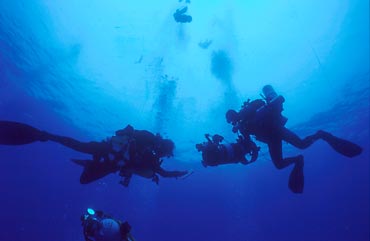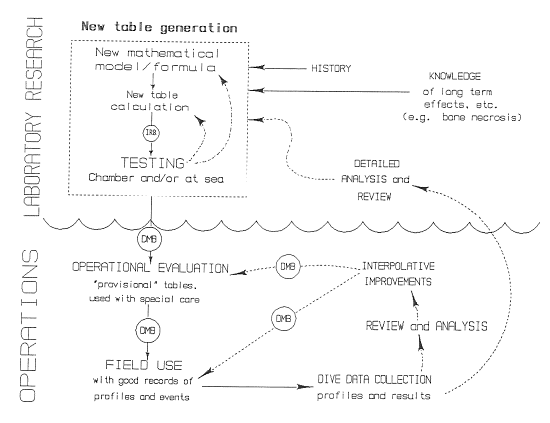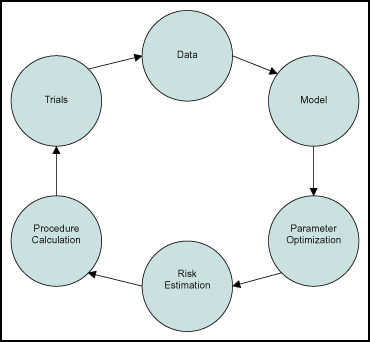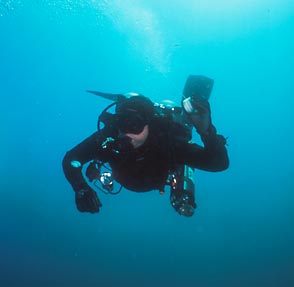How Are You Feeling? New Horizons in the Study of Decompression
How Are You Feeling?
|
 |
| Decompression in the blue water of the Caribbean. Photo ©Dickie Walls |
Discussions of decompression theory inevitably center on theories involved in creating different models and algorithms. In this day and age of diver-worn computers and portable laptop decompression schedules, many divers use this information to create personalized models for efficient decompression. As a result, many divers are starting to rely on this technology without understanding what has gone into making it possible. More attention should be placed on understanding the empirical data that is behind these easy-to-use technologies.
A current literature search will yield theories that range from the early rules and deterministic approaches of Haldane to more recent and widely controversial bubble and probabilistic models. Here, opinion papers are more numerous than actual scientific publications. Furthermore, to anyone who is willing to expend the time to sort through the existing plethora of information, information of relative scientific merit and quality, the Internet provides access to it all from the comforts of home or office. The search continues for the "Holy Grail of Diving"--the elimination of Decompression Sickness (DCS). DCS continues to be a random event that contains many variables1, many of which remain nebulous and ill-defined. Validation of tables and algorithms with decompression trials is a very expensive and time-consuming process meant to ensure that profiles do not produce an unacceptable incidence of DCS. These trials have not only provided the diving community with a wealth of knowledge about DCS, they have also served to broaden the field of Diving Medicine as a whole. It is important here to make a distinction between the validation or verification of decompression tables and the validation of decompression models. Dr. Ed Thalmann has stated, "If you are validating a model, you need decompression sickness in order to know where you are. If you are validating a table, your end point is you do not want any decompression sickness."2 The occurrence of DCS in controlled, supervised model testing is a beneficial and necessary part of the process. Indeed, the information obtained from the experimental DCS hit and the subsequent 287 minutes of a US Navy Treatment Table Six is invaluable for the creation of safe profiles for the community as a whole. However, when this same hit occurs as a result of your weekend away from the office, it is an entirely different situation.How does the validation process work?
In 1989, the Undersea and Hyperbaric Medical Society (UHMS) held a workshop on the Validation of Decompression Tables chaired by Heinz Schreiner. Figure 1 is a diagram originally proposed by Dr. Elliott and edited for final print by Drs. Hamilton and Schreiner. 2

Figure 1
A more recent diagram of decompression table design by Drs. Vann, Gerth, and Southerland, breaks down the sequence into a more simple validation cycle (Figure 2). 3
 |
| Figure 2: The cyclic process by which risk estimation is used to develop decompression procedures. |
This figure depicts validation as a process that begins and ends with data. In a perfect world, the cycle would be continual with each new rotation adding to the knowledge base of the causation of DCS. However, collection, management, interpretation and the final representation of the data collected is wholly dependent on preexisting hypothesis of study and often the biases of the research team.
What is Decompression Data? The challenges of collection, analysis and interpretation of decompression data has been the topic of numerous papers and meetings throughout the years. At the 1991 repetitive diving workshop, Dr. Hamilton stated, "One thing that makes dive data particularly important in this technology area is the dependence of decompression and other diving techniques on prior experience."4 This statement brings to light the particularly important point that the research we conduct today is an additive process which is based upon the experience and knowledge gained from past investigations, starting with the works of pioneers such as Haldane and Bühlmann.In current discussions, most researchers agree that the data collection should include the pressure profile, breathing gas, temperature, workload, outcome, and treatment information.5 The data can then be categorized in numerous ways for use in the validation process.
What is Data Classification? Primary vs. Secondary
Data have historically been separated into one of two categories: 6,7- Primary data is the term used to describe information that has been collected in the laboratory under specific conditions with medical supervision. The laboratory conditions allow for more precise control of the observation and documentation of events. Primary laboratory data is important because the conditions are more uniformly controlled. This data is typically used for calibrating decompression models or algorithms.
- Secondary data is information collected in a fashion that is less precise than primary data and can vary with respect to exposure, environmental conditions and numerous physiological factors. However, field studies are valuable because the variability encountered allows for verification of the estimated risk.
 |
| Photo ©David Rhea |
1. Weathersby P.K., Homer L.D. and Flynn E.T. On the likelihood of decompression sickness. J. Appl. Physiol.: Resp. Environ.: 1984; 57(3): 815-25. 2. Thalmann E.D. Discussion following Dr. Lehner, In: Schreiner H.R. and Hamilton R.W. eds. 1989 May. Validation of decompression tables. UHMS 74(VAL)1-1-88. Bethesda, MD: Undersea Hyperbaric Medical Soc. 3. Vann R.D., Gerth W.A. and Southerland D.G. June 1992. Modeling and Validation. In the proceedings of the 1990 Hypobaric decompression Sickness Workshop, pp. 247-257, Ed. A.A. Pilmanis. Air Force Systems Command AL-SR-1992-0005. 4. Lang M.A., Vann R.D. March 1991. AAUS Repetitive Diving Workshop. 5. Weathersby P.K., Survanshi S.S., Nishi R.Y. and Thalmann E.D. Statistically based decompression tables VII: Selection and treatment of primary air and N2-O2 data. Bethesda, MD. NMRI tech re 92-85, 1992. 6. Weathersby P.K. and Survanshi S.S. 1990. Data quality for decompression modeling. In Operational Dive and Decompression Data: Collection and Analysis, pp. 94-99, Ed. W. Sterk and R.W. Hamilton. EUBS Pub (DATA) 17-8-90. 7. Shields T.G. and Lee W.B. 1986. The Incidence of Decompression Sickness Arising from Commercial Offshore Air-Diving Operations in the UK Sector of the North Sea During 1982-83. Robert Gordon's Institute of Technology and Grampian Health Board Report. 8. Vann R.D. and Thalmann E.D. Decompression physiology and practice. In The Physiology and Medicine of Diving, 4th edition, pp. 376-432. Ed. P.B. Bennett and E.H. Elliott. London: Bailliere Tindall.
All rights reserved.

